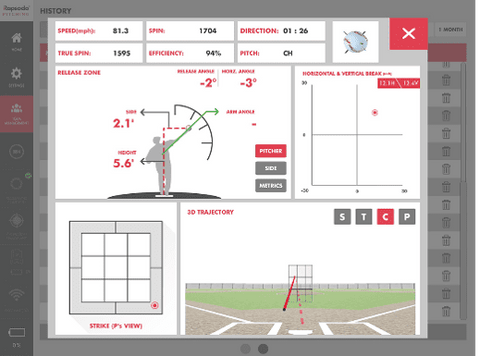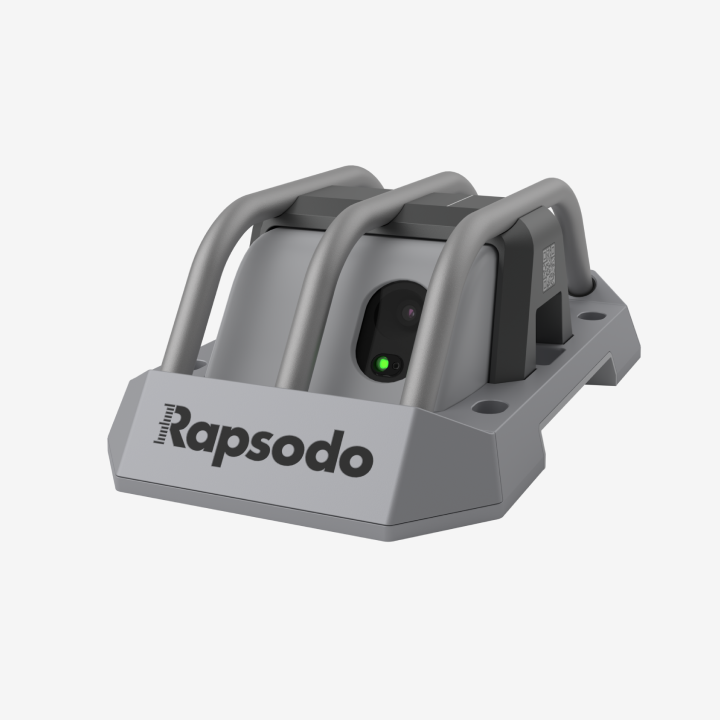If you want to learn how to throw a changeup pitch like the pros, a key step is to accurately measure the speed and spin. There are several types of changeup grips and with Rapsodo data you will know how well you are mastering your pitches.
In this article, we are going to take a closer look at what a changeup is, different ways to throw many types of changeups, and the science of changeups using Rapsodo technology.
What is a Changeup Pitch?
A changeup is an off-speed pitch that is usually thrown to make the batter think it's a fastball, but is actually much slower. The slower speed combined with deception confuses the batter's timing.
Although the changeup is one of the slowest speed pitches, it can be a great pitch for deceiving hitters.
When performed correctly, the hitter will swing before the pitch arrives causing a strike out or weak contact with the ball.
Different Ways to Throw A Changeup
There are multiple ways to pitch a changeup. All are achieved by changing your grip on the ball.
C-Change
Similar to gripping a curveball, place your thumb and middle finger on the top and bottom seams of your ball. Then, throw the “C” shape directly at your target.
Throwing the C-Change will be difficult at first, as many pitchers struggle with throwing the C directly at the target. When thrown properly, this changeup grip is quite challenging to hit.
Circle Changeup
After you’ve mastered the C-Change grip, you can start making it more advanced with the circle changeup.
Start by placing your index finger and thumb together into the shape of a circle. When correctly done, it will look as if you are making an “OK” sign with your throwing hand. Hold the ball underneath your pinky, middle, and ring fingers. The ball will be held in place with the “OK” symbol made by your index finger and thumb.
This pitch is thrown with the same arm action and body mechanics as a fastball. As you are throwing the circle changeup, slightly turn the ball over to throw the circle to the target.
Three-Finger Changeup
Often called the straight changeup, this pitch is one of the easier changeup grips. It’s perfect for younger pitches or those with smaller hands.
To pitch a three-finger changeup, bring your pinky and thumb together. This will leave your index, ring, and middle finger open to grip the ball.
Position the smooth leather portion of the baseball under your thumb and pinky. Maintaining arm speed is crucial to this pitch, as it’s part of selling the illusion that it’s high speed. Use the same arm motion, arm speed, and body mechanics as a fastball when throwing this changeup.
How Changeup Movement Impacts Hitters
Different changeup grips have different movement, but all mimic the same arm action as pitching a fastball. As a result, Hitters assume the ball is moving at a higher speed. This causes the batter to swing too early, often completely missing or clipping just the side of the ball.
The Science of a Changeup Using Rapsodo Technology
Understanding the aspects of each pitch is vital to improving your game. Let’s discuss how to strike out the competition using the Rapsodo Pitching 2.0 training device.
After mastering the fastball and curveball, learning an off-speed pitch will fully round out your pitching arsenal.
With the fastball and curveball pitches, a pitcher can cover 35.4 inches of vertical break and 17.7 inches of horizontal break.
Establishing an off-speed pitch, such as the changeup, increases the overall break area for our pitcher. The changeup is thrown with the depth of the fastball and arm-side movement that creates a fading effect.
Why You Should Learn to Throw a Changeup
Typically pitchers who generate above average lift on their fastballs benefit most from learning a straight changeup or a circle changeup.
The straight changeup will rely most on velocity and vertical break separation from the fastball. The circle changeup has a more pronounced fading action, which adds a horizontal component to the pitcher’s break chart.
The straight and circle changeup pitches both are predominantly in the vertical plane of our movement matrix. To contrast this, it would be wise to incorporate some additional horizontal movement with this pitch.
Here is a bullpen sample of our pitcher’s current changeup:

How Average Speed Efficiency Impacts The Changeup
For any pitcher, the main goal with this pitch is to kill as much vertical break as possible. This is typically done through incorporating more arm-side horizontal break than the traditional fastball.
To accomplish this, adjust your spin direction closer to 2:00. Don’t alter the average spin efficiency too much. The right amount of reducing the average spin efficiency will aid in vertical break seperation.
By moving your spin direction closer to 2:00, the ball will tilt more horizontally out of the hand. If the pitches’ spin efficiency remains in the 90s, the pitches’ vertical break would go down. The greatest gain would be seen in arm-side horizontal break.
We can see an example of this with this pitch from our same pitcher:

Improve Your Changeup by Reducing Spin Efficiency
Reducing spin efficiency adds a bullet-like spin to the ball. This allows the natural forces to act more strongly against it, giving our pitcher the desired vertical break separation.
The horizontal break numbers may not significantly improve due to the decrease in spin-induced movement.
Our pitcher once again was able to provide an example of this particular change:

Understand Each Pitch with Rapsodo Tracking Technology
Fully understand the mechanics of each pitch with Rapsodo’s industry-leading player development tools.
This same technology is used by all 30 MLB teams and over 1,200 colleges in the United States. Rapsodo’s technology provides all the analytics needed to add a competitive edge to your game. In fact, 90% of our athletes are NCAA champions.
Learn more about Rapsodo’s full-line of baseball data tracking tools.
















